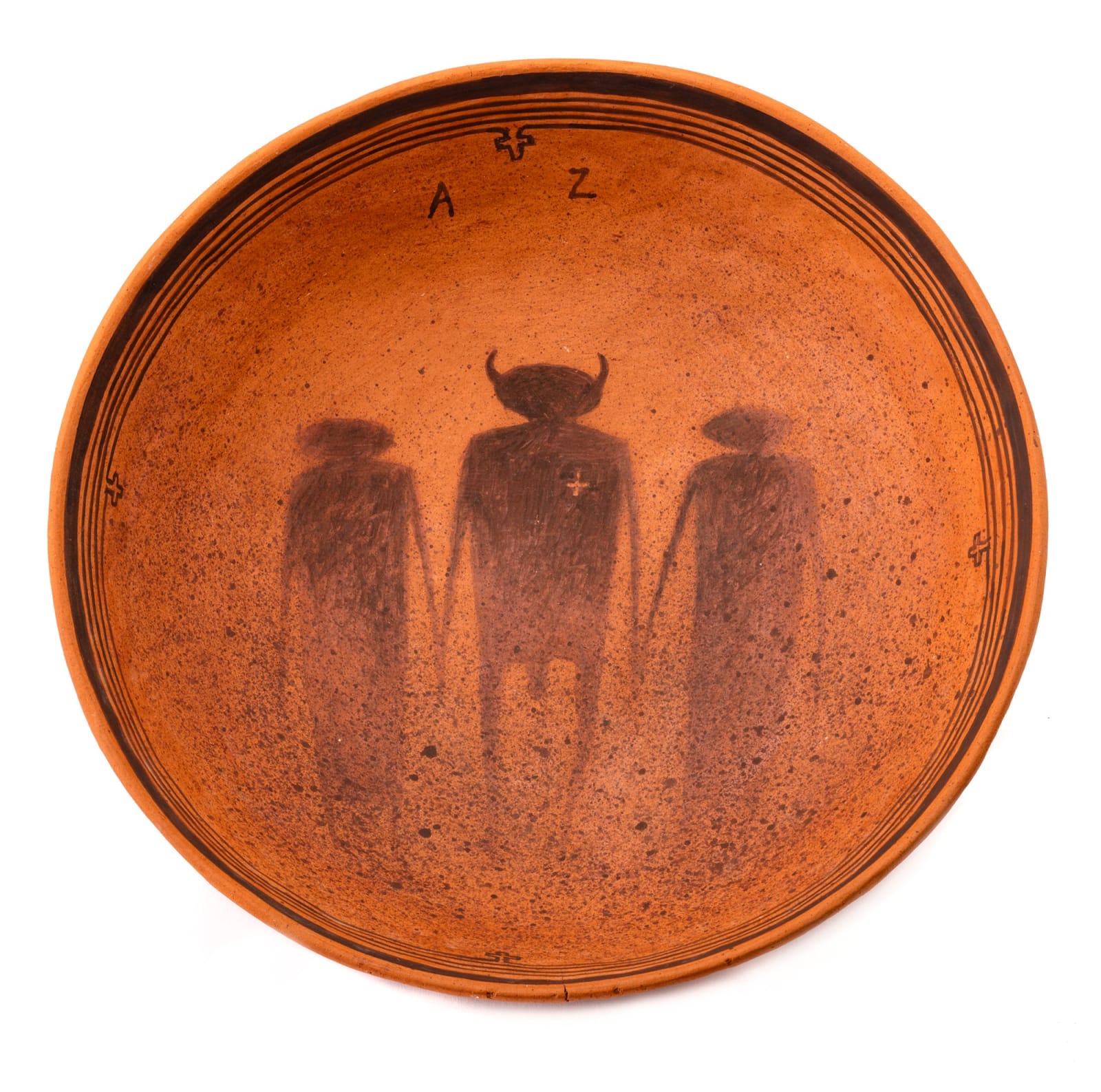CARL BEAM, R.C.A. (1943-2005) ANISHINAABE (OJIBWE)
dated 1982 to the accompanying Whetung Gallery invoice.
ESTIMATE: $4,000 — $6,000
PRICE REALIZED: $3,910.00
Further images
In 1980, Carl Beam moved to New Mexico, where he learned the Anasazi “coil-and scrape” manufacturing technique. His tutelage also included finding and identifying appropriate clays, which he then used to create works made from suitable clays native to his home of Manitoulin Island. Thereafter, Beam created bowls which intrigued viewers with their combination of revival Anasazi and Mimbres designs with both Woodlands and Western imagery.
In the centre from an abstract display of black sprinkles that gently drift about on the unglazed orange-red ground, emerges three shadowy figures whose hands are locked together. The arrangement of this shamanic family is a trio that obviously captivated the artist. He repeated it several times throughout his career, including for his commission at the entrance of the Ojibwe Cultural Foundation. In particular, the central horned figure is recurrent in Beam’s works. This horned silhouetted figure is a transmutation of the enduring images of the petroglyphs, which Beam described as “figures from our cultural past” [1]. Concentric bands around the rim echo design elements found on ancient Mimbres bowls but Beam interrupts the innermost belt with four cross shapes. The cross motif can also be found on the left breast of the horned figure, in place of its heart. This motif is repeated in Beam’s work, as well as in the works of other Anishinaabe artists, and is a symbol of the four directions. At the top, Beam, writes the letters A and Z, which may symbolize the notion of the fundamental or elemental, a reference to the natural materials of the bowl and to Beam’s own personal zenith, “let us remember that we are all related” [2].
1. As cited in Greg A. Hill, ed., Carl Beam: The Poetics of Being, 2010, p. 57.
2. Ibid., p. 41
References: For a very similar example of close vintage, see Shaman Family, 1984, illustrated in Robert Reid,"Ontario; Carl Beam in Brantford," Art Post Magazine, August/September, 1985, p. 30. For similar examples from the 2000s, see figs. 19 and 21 in Greg A. Hill, ed., Carl Beam: The Poetics of Being, (Ottawa: National Gallery of Canada, 2010), pp. 43-44. For additional information on Beam’s use of the Anasazi pottery technique, see Virgina Eichorn, “All Related: The Ceramic Work of Carl Beam,” in Carl Beam: The Poetics of Being, Greg A. Hill, ed., (Ottawa: National Gallery of Canada, 2010), pp. 41-59. See also Alan Corbier and Crystal Migwans, “Foundations: Carl Beam’s Work and the Continuing Influence Among Manitoulin’s Anishinaabek”in Carl Beam: The Poetics of Being, Greg A. Hill, ed., (Ottawa: National Gallery of Canada, 2010), pp. 51-52. In a brief note in Gerald McMaster, ed., Reservation X, (Hull, QC: Canadian Museum of Civilization, 1998), p. 26. It is worth noting that Beam’s reverence for the medium was so great that, when he returned to Manitoulin Island in 1983, he applied the skill to build an adobe (mudbrick) style home and advocated that it be adopted by others in the community. For a discussion of Shamanic figure(s), see Alan Corbier and Crystal Migwans, “Foundations: Carl Beam’s Work and the Continuing Influence Among Manitoulin’s Anishinaabek”in Carl Beam: The Poetics of Being, Greg A. Hill, ed., (Ottawa: National Gallery of Canada, 2010), pp. 56-7. The Beams’s early works were exhibited at the Maxwell Museum of Anthropology in Albuquerque in 1982 but it was not until 2004 when The Canadian Clay and Glass Gallery in Waterloo premiered the show It’s All Relative: Carl, Ann, and Anong Beam that Beam’s ceramics, to us, began to be fully appreciated. We are unable to find any records of the 1982 exhibition but it is discussed contemporaneously in Joseph Traugott, “Two Artists’ Works Show Slight Influence of Indian Design,” Albuquerque Journal, 14 March 1982, p. D-2 and subsequently in Robert Reid, "Ontario; Carl Beam in Brantford," Art Post Magazine , August/September, 1985, pp. 29-30 and John K. Grande, “Carl Beam: Dissolving Time,” The Canadian Forum, Vol. 72, No. 820, pp. 19-23.
Provenance
Whetung Gallery, Curve Lake, Ontario;
Acquired from the above by the present Private Collection, Toronto, accompanied by a copy of the original invoice
Join our mailing list
* denotes required fields
We will process the personal data you have supplied in accordance with our privacy policy (available on request). You can unsubscribe or change your preferences at any time by clicking the link in our emails.








